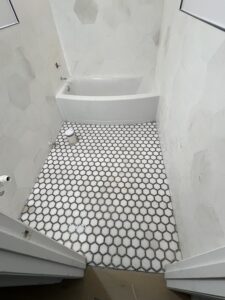
Image by Alessandroguerriero from Getty Images via Canva
Choosing the best paint for walls is a crucial step in transforming the look and feel of your home. With so many options available, finding the right type and finish can be overwhelming. This guide breaks down the different types of paint and offers practical tips to help you select the perfect one for each room in your house.
Whether you’re looking to brighten up a small space or add durability to a high-traffic area, understanding the nuances of wall paint can make a significant difference. Those who prefer a professional touch should consider enlisting the help of experienced painting services to achieve flawless results.
Different Types of Paint for Walls
There are several types of paint available for walls, each suited to different needs and preferences. Choosing the right paint can greatly impact the appearance and durability of your walls. Here is a list of common types of wall paint:
- Matte Paint
- Eggshell Paint
- Satin Paint
- Semi-Gloss Paint
- High-Gloss Paint
- Flat Enamel Paint
- Textured Paint
- Chalkboard Paint
- Milk Paint
- Acrylic Paint
- Oil-Based Paint
- Latex Paint
How to Choose the Best Paint for Your Walls
Choosing the right paint for your walls can significantly impact the general look and feel of your home. With so many options available, it’s vital to understand the different types of paint and their benefits. Here are seven tips to help you make the best choice for your walls.
- Consider the Room’s Function
The function of a room is crucial when selecting paint. For areas with high traffic, such as kitchens and bathrooms, choose a durable and washable paint like satin or semi-gloss. These finishes are resistant to moisture and stains, making them easier to maintain. For bedrooms and living rooms, where a softer look is often preferred, matte or eggshell finishes provide a more elegant appearance and hide imperfections better.
- Evaluate Light Exposure
Light exposure in a room affects how paint color looks. Rooms with abundant natural light can manage darker colors, which may create a cozy ambiance. Conversely, rooms with limited natural light benefit from lighter colors that reflect light and make the space feel larger and brighter. Always test paint samples on your walls and observe them at different times of the day to see how they react to changing light conditions.
- Understand Paint Types
Different paint types offer varying levels of durability and finish. Latex paint is water-based, making it easy to clean and environmentally friendly, ideal for most interior walls. Oil-based paints, though less common, provide a durable, smooth finish, perfect for trimming and molding. However, they require longer drying times and can be more challenging to clean up. Understanding the pros and cons of each type helps you select the best option for your needs.
- Choose the Right Finish
Paint finishes range from flat to high gloss, each with its advantages. Flat and matte finishes hide imperfections but are less durable and harder to clean. Eggshell and satin finishes strike a balance, offering a slight sheen and better durability, which is suitable for most rooms. Semi-gloss and high-gloss finishes are highly durable and easy to clean, making them superior for high-traffic areas, trim, and cabinetry.
- Test Paint Colors
Never rely solely on paint swatches or online images. Purchase small samples of your chosen colors and apply them to a small section of your wall. Observe how the color looks in different lighting conditions throughout the day. This practice helps you avoid costly mistakes and ensures you are satisfied with your selection before committing to a full paint job.
- Consider Paint Quality
Investing in high-quality paint can save you time and money in the long run. Premium paints offer better coverage, reducing the number of coats needed and providing a more uniform finish. They are also more durable, resisting fading, chipping, and stains better than cheaper alternatives. While higher-quality paint may cost more upfront, its longevity and ease of application make it a worthwhile investment.
- Think About Future Maintenance
Some paints are designed to be more resistant to wear and tear, making them easier to maintain. If you have children or pets, consider paints that are specifically formulated to withstand frequent cleaning and scrubbing. Washable paints are a practical choice for hallways, kitchens, and children’s rooms, where walls are more likely to get dirty. Choosing a paint with good washability ensures your walls stay looking fresh and new longer.
FAQs

Image by sssss1gmel from Getty Images via Canva
What is the best paint for walls in a small room to make it look larger?
The best paint for walls in a small room to make it look larger is a light, reflective color like white, soft pastels, or light neutrals. These colors enhance the room’s natural light and create an illusion of more space.
How can I minimize paint fumes in my home?
To minimize paint fumes, choose low-VOC (volatile organic compounds) or no-VOC paints, which emit fewer harmful chemicals. Ensure proper ventilation by opening windows and using fans to circulate fresh air. Additionally, consider utilizing an air purifier to help remove any lingering fumes. Painting in smaller sections and taking breaks can also help reduce prolonged exposure to paint fumes.
What is the best paint for walls with high humidity, such as in a bathroom?
The best paint for walls in high-humidity areas like bathrooms is a mildew-resistant, moisture-resistant paint with a semi-gloss or satin finish. These finishes are easier to clean and help prevent mold and mildew growth.
What is the best way to prepare walls before painting?
Before painting, it’s essential to properly prepare the walls to ensure a smooth and lasting finish. Begin by cleaning the walls thoroughly to remove dirt, dust, and grease. Next, sand any rough areas or imperfections to create an even surface. Finally, a primer is applied to enhance paint adhesion and achieve a uniform look. Proper wall preparation greatly enhances the durability and appearance of the paint job.
Conclusion
Choosing the best paint for walls can transform your home, making spaces feel brighter, cozier, or more elegant. By considering factors like room function, light exposure, and paint type, you can achieve a beautiful and durable finish. Invest in quality paint and proper preparation to ensure long-lasting results.
Enhance your home with professional painting services at Miller 86. Serving Winter Haven, FL, and nearby areas, Miller 86 offers top-quality house painting to bring your vision to life. Contact us today to schedule your consultation.





